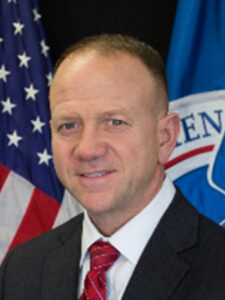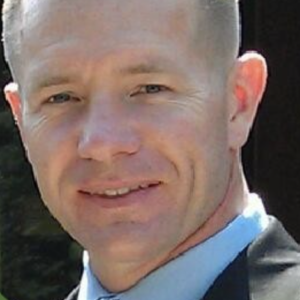Each year, Homeland Security Today honors shining stars in the community who are making their own unique, invaluable contributions to advance the mission of keeping America safer from myriad threats. Their strong commitment to mission touches every part of their work, from day-to-day operations to special projects and work in the community.
Yosry Barsoum, Vice President and Director, Homeland Security Systems Engineering and Development Institute, MITRE
 From the White House and DHS Secretary’s office to the deputy sheriff working in remote Arizona, Yosry Barsoum is making a difference in homeland security. At the helm of MITRE’s Center for Securing the Homeland (CSH) is Yosry Barsoum, Vice President and Director leading two MITRE-operated Federally Funded Research and Development Centers: the Homeland Security Systems Engineering and Development Institute (HSSEDI) for the Department of Homeland Security (DHS), and the National Cybersecurity FFRDC for the National Institute of Standards and Technology.
From the White House and DHS Secretary’s office to the deputy sheriff working in remote Arizona, Yosry Barsoum is making a difference in homeland security. At the helm of MITRE’s Center for Securing the Homeland (CSH) is Yosry Barsoum, Vice President and Director leading two MITRE-operated Federally Funded Research and Development Centers: the Homeland Security Systems Engineering and Development Institute (HSSEDI) for the Department of Homeland Security (DHS), and the National Cybersecurity FFRDC for the National Institute of Standards and Technology.
Since joining the company in 1990, Barsoum has served in many roles at MITRE including technical and program management positions focusing on cross-agency priorities, technical quality, and R&D strategy and execution, all while ensuring their alignment with emerging priorities and technologies. From 2012-2018, Barsoum served as MITRE’s Portfolio Director for the Army Program Division, developing the portfolio vision, priorities, and outcomes, shaping the program to achieve high-priority customer outcomes and ensuring the delivery of high quality, timely products.
Barsoum’s commitment to the mission and to the delivery of high quality, timely products led to his selection as the Vice President and Director of MITRE’s CSH in 2018. Since then, the HSSEDI work program has grown by approximately 60 percent. In addition to oversight of both FFRDCs, Barsoum is also responsible for making strategic investments to advance capabilities and solutions for the homeland security enterprise. In FY22, Barsoum made strategic investment in the development and delivery of uncrewed aerial systems for first responders. The promise of drones for public safety far exceeds the ways drones are currently deployed by local first responders. Barsoum recognizes this potential and is serving as a catalyst to move this mission space forward through research and development.
- In September 2022, fire chiefs from across the country joined leading drone manufacturers at a MITRE CSH hosted event, the Fire/Rescue Drone Summit, featuring U.S. congressional representatives, to collaboratively co-create the future of drones for public safety.
- Before the end of 2022, a local sheriff’s office will launch a MITRE-created drone to detect human trafficking, and public safety agencies from across the country will join another MITRE-led initiative to dramatically improve the safety and skill of the nation’s public safety remote pilots.
- In development, MITRE’s Drone Selector tool will provide first responders with a trusted source to find the drone that best meets their specific needs by weeding through all the specifications.
- MITRE is building a drone range to test and pilot capabilities, specifically for first responders, with construction expected to start before the end of 2022.
In addition to his investment in drones for first responders, Barsoum also made strategic homeland security investments in a Smart Cities laboratory, election security laboratory, and a digital crimes investigation capability, just to name a few. Barsoum is committed to delivering innovation to the users — whether it is Army soldiers or first responders — to improve their ability to do their jobs and advance mission outcomes. His keen understanding of mission needs, fast operational pace, and collaborative nature are driving innovation, enabling government and industry to move forward with new capabilities.
Troy Choplin, Assistant Director of Emergency Management, Payne County, Okla.
 Troy Choplin, Assistant Director of Emergency Management for Payne County, Okla., is active in numerous areas, increasing the capabilities of first responders and safety in the county. He is currently chairing the committee to create a countywide radio program in which all first responders will be on the same system, allowing increased and common communications throughout events in the county, and with other counties and the state emergency management department.
Troy Choplin, Assistant Director of Emergency Management for Payne County, Okla., is active in numerous areas, increasing the capabilities of first responders and safety in the county. He is currently chairing the committee to create a countywide radio program in which all first responders will be on the same system, allowing increased and common communications throughout events in the county, and with other counties and the state emergency management department.
Choplin also designed, organized, and ran a tabletop exercise involving 17 organizations and almost 60 people in a simulated event in the county’s Election Board office. It was designed in a way that was both realistic (using real threats) and adaptable to other government offices, and is being used across the state in other election board offices as well as adapted for university use. Choplin also serves as a volunteer fireman in his local fire department, and is an Adjunct Professor at Oklahoma State University. He produces the weather forecasts when needed for determining burn bans, and conducts safety training classes for county personnel. One of his key strengths, besides leadership, is helping develop good working relationships between people who would not normally even meet until there was an emergency. His exercises have all drawn great praise for this element, and increase the safety of not only the people working an emergency, but also the community and county he serves.
J. Michael Daniel, President and CEO, Cyber Threat Alliance
 J. Michael Daniel, president and CEO of the Cyber Threat Alliance, is a tireless advocate for cyber threat information sharing at speed. In his government career, Daniel served at the Office of Management and Budget for over 16 years. Daniel then served for almost 5 years as the advisor to the president on cybersecurity matters, leading the development of government-wide cyber policy and overseeing implementation of that policy. Upon leaving government, he moved to lead the Cyber Threat Alliance, a nonprofit organization that is working to improve the cybersecurity of our global digital ecosystem by enabling near real-time, high-quality cyber threat information sharing among companies and organizations in the cybersecurity field. He extends his service to the government in his current role, working to ensure that the federal agencies and contractors that support them are educated on the importance of sharing threats to the federal ecosystem. His pivotal work to change culture and build trust across and between government and the private sector is steadfast. His work to help combat the pervasive cyber threat across 18 critical infrastructure segments has made a significant impact for this nation and across the globe. Throughout this career, he has served the federal government by making a measurable impact in the cyber mission.
J. Michael Daniel, president and CEO of the Cyber Threat Alliance, is a tireless advocate for cyber threat information sharing at speed. In his government career, Daniel served at the Office of Management and Budget for over 16 years. Daniel then served for almost 5 years as the advisor to the president on cybersecurity matters, leading the development of government-wide cyber policy and overseeing implementation of that policy. Upon leaving government, he moved to lead the Cyber Threat Alliance, a nonprofit organization that is working to improve the cybersecurity of our global digital ecosystem by enabling near real-time, high-quality cyber threat information sharing among companies and organizations in the cybersecurity field. He extends his service to the government in his current role, working to ensure that the federal agencies and contractors that support them are educated on the importance of sharing threats to the federal ecosystem. His pivotal work to change culture and build trust across and between government and the private sector is steadfast. His work to help combat the pervasive cyber threat across 18 critical infrastructure segments has made a significant impact for this nation and across the globe. Throughout this career, he has served the federal government by making a measurable impact in the cyber mission.
Bruce Dodd, Deputy Director of Field Operations for Preclearance, U.S. Customs and Border Protection
 Bruce Dodd is pioneering new approaches and technologies within CBP Preclearance to drive the mission forward. As the Deputy Director, Dodd has been instrumental in a large organizational restructuring effort to streamline efforts and promote increased collaboration across CBP’s international operations and programs. D-DFO Dodd’s mindset and role in the restructuring of international operations will help transform the way CBP expands its borders and further aid in efforts to build international partnerships to enhance national and economic security.
Bruce Dodd is pioneering new approaches and technologies within CBP Preclearance to drive the mission forward. As the Deputy Director, Dodd has been instrumental in a large organizational restructuring effort to streamline efforts and promote increased collaboration across CBP’s international operations and programs. D-DFO Dodd’s mindset and role in the restructuring of international operations will help transform the way CBP expands its borders and further aid in efforts to build international partnerships to enhance national and economic security.
Sean Haglund, Associate Director, Department of Homeland Security Office of Bombing Prevention
 Sean Haglund led the Office for Bombing Prevention (OBP), part of the Department of Homeland Security’s Cybersecurity and Infrastructure Security Agency (CISA), through a tumultuous year to overcome major infrastructure security challenges. In 2022, OBP Associate Director Haglund spearheaded the office’s efforts to implement the National Policy for Countering Improvised Explosive Devices (IEDs), the policy that guides our nation to secure the U.S., its allies, partners and interests against IEDs. His leadership has helped the U.S. better prevent, protect against, respond to, and mitigate the use of explosives against critical infrastructure, the private sector, and federal, state, local, tribal, and territorial entities.
Sean Haglund led the Office for Bombing Prevention (OBP), part of the Department of Homeland Security’s Cybersecurity and Infrastructure Security Agency (CISA), through a tumultuous year to overcome major infrastructure security challenges. In 2022, OBP Associate Director Haglund spearheaded the office’s efforts to implement the National Policy for Countering Improvised Explosive Devices (IEDs), the policy that guides our nation to secure the U.S., its allies, partners and interests against IEDs. His leadership has helped the U.S. better prevent, protect against, respond to, and mitigate the use of explosives against critical infrastructure, the private sector, and federal, state, local, tribal, and territorial entities.
Haglund skillfully led OBP in 2022 during a time of significant security concerns that included an exponential spike in bomb threats targeting Historically Black Colleges and Universities (HBCUs). More than 30 of the 101 HBCUs received 49 bomb threats in January and February alone. Haglund demonstrated exceptional leadership, creativity, and collaboration while leading the office to develop and implement mitigations to counter the threat and increase resilience. Haglund led the team to assess the threat landscape, coordinate response efforts, host training seminars, tailor products and resources to schools, and provide key capacity-building and preparedness assistance to stakeholders.
More specifically, Haglund led OBP efforts to respond to the threats against HBCUs by:
- Helping lead a bomb threat forum with the Atlanta University Center Consortium, a nonprofit operating on behalf of Clark Atlanta University, Morehouse College, Morehouse School of Medicine, and Spelman College. It is the world’s oldest and largest association of HBCUs. The discussion provided critical guidance for managing bomb threats while keeping students, facility, and staff safe from harm.
- Testifying before the U.S. House Committee on Oversight and Reform about OBP’s ability to respond to emerging threats, including providing a vast array of resources that help prevent bomb attacks
- Overseeing the delivery of 27 courses that trained 1,253 people
- Developing a bomb threat plan template for universities, a mass bomb threat awareness job aid, and co-developing a CISA tabletop exercise package
- Publishing a bulletin (called the TRIPwire Awareness Bulletin) that explains how to respond to mass bomb threat campaigns
Haglund drove strategy for a wide range of free, innovative, capacity-building programs that now serve as the prototype for how to prevent, protect against, respond to, and mitigate the use of explosives. For instance, he oversaw OBP’s Counter-IED Training and Awareness effort — a range of internationally accredited trainings in multiple formats delivered to participants from the public, major corporations, and high-profile agencies at all levels of government. OBP trained 18,000 people this year alone, bringing the total number of people OBP has now trained to 150,000 — a remarkable achievement.
Additionally, Haglund helped spearhead the growth of the Bomb-Making Materials Awareness Program, which is laser-focused on preventing IED attacks early, when adversaries try to acquire the necessary materials. This included collaborating closely with the FBI on Operation Flashpoint, an initiative that raises awareness among retailers across the U.S. of the dangers of domestic violent extremists and others purchasing explosive precursor chemicals from stores. The impact: Retailers and people across the nation now know about Operation Flashpoint, including the 8 million people who watched a segment about it on NBC Nightly News with Lester Holt earlier this year. Such efforts have led more people to report suspicious activity that can be connected to bombs.
Haglund also led strategic efforts in many other areas. This included development of OBP’s Annual Operating Plan, which guided the office’s activities to increase capacity, speed delivery, use innovation and improve performance. Additionally, in 2022, he helped lead a rewrite of Presidential Policy Directive 17 (PPD-17): Countering IEDs, the policy that guides our nation to counter IEDs and secure the U.S., its allies, partners and interests from IEDs.
Haglund has been the driving force behind OBP’s key efforts to increase preparedness, reduce risk, and ultimately save lives and make the U.S. a more secure country.
HSI Cyber Crimes Center

The HSI Cyber Crimes Center (C3), led by Acting Division Chief Ronald Appel and Unit Chief Daniel Lezcano, is at the vanguard of investigating crypto-based cybercrimes, and was integral in the 2022 criminal charges against six defendants in four separate cases for their alleged involvement in cryptocurrency-related fraud, including the largest known Non-Fungible Token (NFT) scheme charged to date. HSI C3 has led numerous digital asset trainings with foreign law enforcement partners in over 20 countries to expand the scope of online investigations, dark web, and cryptocurrency investigations.
HSI C3 is responsible for identifying and targeting any cybercrime activity in which HSI has jurisdiction. HSI C3 supports HSI’s mission through the programmatic oversight and coordination of investigations of cyber-related criminal activity, and provides a range of forensic, intelligence and investigative support services across all HSI programmatic areas. HSI C3 brings together highly technical assets dedicated to conducting trans-border criminal investigations of cyber-related crimes within the HSI portfolio of customs and immigration authorities.
C3 is made up of the Cyber Crimes Unit, the Child Exploitation Investigations Unit and the Computer Forensics Unit. This state-of-the-art center offers cyber-crime support and training to federal, state, local and international law enforcement agencies. C3 also operates a fully equipped computer forensics laboratory, which specializes in digital evidence recovery, and offers training in computer investigative and forensic skills.
Nazrul Islam, Chief of the Health Assessment Team, Office of the Chief Information Officer, Department of Homeland Security
 In FY22, Nazrul Islam was tasked with his most challenging assignment yet at Department of Homeland Security (DHS) Office of the Chief Information Officer, assuming the lead of the Program Health Assessment Team. This team evaluates major and standard IT investments across DHS and develops the associated risk scores. The chief information officer reviews and reports this score as a vital aspect of the DHS Federal IT Acquisition Reform Act rating, which is published on the Federal IT Dashboard. Islam has been critical to the success of this effort by effectively managing contractor staff to identify and report program status.
In FY22, Nazrul Islam was tasked with his most challenging assignment yet at Department of Homeland Security (DHS) Office of the Chief Information Officer, assuming the lead of the Program Health Assessment Team. This team evaluates major and standard IT investments across DHS and develops the associated risk scores. The chief information officer reviews and reports this score as a vital aspect of the DHS Federal IT Acquisition Reform Act rating, which is published on the Federal IT Dashboard. Islam has been critical to the success of this effort by effectively managing contractor staff to identify and report program status.
Islam coordinates with the Office of the Chief Technology Officer Directorate (CTOD) Program Engagement Integrated Product Team (IPT) to ensure Program Health Assessment results inform CTOD Technical Assessments and the Enterprise Architecture Board. This ensures that programs receive support to increase their risk scores. Islam balances competing interests to ensure customer expectations are met. He also briefs senior program managers and CTOD leadership on status updates. Islam provides all reports and responses for Program Health services in a comprehensive and timely manner. His successful pivot to this new role enables CTOD to continue this important service to the DHS mission.
Chief Raied “Ray” Jadallah, Miami-Dade Fire Rescue
 In the early morning hours of June 24, 2021, part of the Champlain Towers South condominium in Surfside, Fla., collapsed. Seventy-two of the 136 units of a 12-story building were involved in the collapse resulting in the loss of 98 lives. Chief Raied “Ray” Jadallah, then Deputy Chief of Miami-Dade Fire Rescue, responded to the incident immediately, coordinating the initial search- and-rescue efforts following the collapse. Jadallah was then tasked as the fire department representative to the Family Reunification Center, taking part in twice-daily briefings, oftentimes having to tell family members that their loved ones had perished in the collapse. This is never an easy task and was compounded by the fact that Jadallah, a Muslim whose family is from Palestine, was interacting with family members of a predominately Jewish community. Jadallah’s compassion and honesty quickly gained their trust as he coordinated a visit to the collapse site for all the family members and ensured throughout the event that it would be the family who would learn first of their family member’s death. For 28 days following the collapse, Jadallah was the point of contact for the families, and he performed in the role with honor, integrity, and compassion.
In the early morning hours of June 24, 2021, part of the Champlain Towers South condominium in Surfside, Fla., collapsed. Seventy-two of the 136 units of a 12-story building were involved in the collapse resulting in the loss of 98 lives. Chief Raied “Ray” Jadallah, then Deputy Chief of Miami-Dade Fire Rescue, responded to the incident immediately, coordinating the initial search- and-rescue efforts following the collapse. Jadallah was then tasked as the fire department representative to the Family Reunification Center, taking part in twice-daily briefings, oftentimes having to tell family members that their loved ones had perished in the collapse. This is never an easy task and was compounded by the fact that Jadallah, a Muslim whose family is from Palestine, was interacting with family members of a predominately Jewish community. Jadallah’s compassion and honesty quickly gained their trust as he coordinated a visit to the collapse site for all the family members and ensured throughout the event that it would be the family who would learn first of their family member’s death. For 28 days following the collapse, Jadallah was the point of contact for the families, and he performed in the role with honor, integrity, and compassion.
Jason Lim, Identity Management Capability Manager, Transportation Security Administration
 Over the past year, Jason Lim has driven strategic transformation at TSA, impacting millions of travelers daily, by implementing innovative biometric and digital identity (DI) solutions that increase traveler throughput and secure TSA checkpoints. In addition to its checked and carry-on baggage screening mission, TSA must verify the identities of 2-3 million passengers per day at more than 400 federalized airports across the United States. Historically, this task has been executed manually by Transportation Security Officers (TSOs) by comparing the passenger in front of them with the photo on the passenger’s identity document (e.g., driver’s license, passport) and cross- checking that with the passenger’s boarding pass. In Fall 2018, Lim led TSA’s effort building a strategic roadmap to explore automation of these repetitive and resource-intensive tasks, namely through the integration of biometrics (e.g., facial recognition) and digital identity solutions into the security checkpoint. The strategy articulated a collaborative, biometric vision for TSA and its aviation security partners. Using new and emerging technologies, Lim and his team have aimed to significantly enhance security effectiveness, streamline operations, and transform the passenger experience while preserving passenger privacy and civil liberties. These goals and objectives were restated and amplified in the release of TSA’s 2022 Identity Management Roadmap.
Over the past year, Jason Lim has driven strategic transformation at TSA, impacting millions of travelers daily, by implementing innovative biometric and digital identity (DI) solutions that increase traveler throughput and secure TSA checkpoints. In addition to its checked and carry-on baggage screening mission, TSA must verify the identities of 2-3 million passengers per day at more than 400 federalized airports across the United States. Historically, this task has been executed manually by Transportation Security Officers (TSOs) by comparing the passenger in front of them with the photo on the passenger’s identity document (e.g., driver’s license, passport) and cross- checking that with the passenger’s boarding pass. In Fall 2018, Lim led TSA’s effort building a strategic roadmap to explore automation of these repetitive and resource-intensive tasks, namely through the integration of biometrics (e.g., facial recognition) and digital identity solutions into the security checkpoint. The strategy articulated a collaborative, biometric vision for TSA and its aviation security partners. Using new and emerging technologies, Lim and his team have aimed to significantly enhance security effectiveness, streamline operations, and transform the passenger experience while preserving passenger privacy and civil liberties. These goals and objectives were restated and amplified in the release of TSA’s 2022 Identity Management Roadmap.
Lim’s approach focuses on measuring technical excellence not only on how well it solves initial stakeholder problems but by anticipating its impact and relevancy to long-term transportation security, thereby extending the impact of the government’s investment. His technical acumen, desire to constantly improve user experience, stakeholder engagement proficiency, and commitment to fostering inclusivity in developing secure standards-driven technology set him apart. His accomplishments are evident in his ability to deliver transformative solutions that are helping airlines and airports resume and improve operations. Lim saw early on the value these solutions could bring to TSA and focused his team on piloting these technologies, which bolster TSA’s ongoing efforts to streamline the traveler experience. Further, as air travel continues to resume and recover, TSA and its partners must continue to be ready to adopt new technology, such as mDLs and DIs, as adoption and use of these credentials are rapidly growing. With projected adoption rates of over 50 percent in the next 10 years, Lim honors TSA’s commitment to the president’s December 2021 Executive Order on improving customer experience and service delivery for the American people. His coalition and consensus-building approach on the federal side enables him to constructively engage with industry stakeholders in both commercial aviation and the technology sector to make measurable progress on shared public-private sector priorities.
U.S. Customs and Border Protection Automated Commercial Environment: Steven Lubel, Branch Chief, Cargo Release; Autumn Maxey, Lead IT Specialist, and Renee Messalle, Director of Entry Summary Accounts and Revenue Development Division with CBP’s Cargo Systems Program Directorate
The Automated Commercial Environment (ACE) clears and processes more than 12 million cargo entries per year valued at over $2.7 trillion in imports, $1.6 trillion in exports and over $90 billion collected in duties, taxes and fees. Customs and Border Protection’s Office of Information and Technology developed and deployed the High Value Asset (HVA) Modernized ACE Portal. With the ACE Portal modernization, CBP transitioned the legacy, unstable and costly legacy infrastructure to a best-in-class Cloud-based Salesforce application. This created a modernized platform for nearly 60,000 trade, partner government agencies, and CBP users that provides a seamless and enhanced user experience facilitating legitimate trade by automating tools and information. This deployment resulted from an extensive partnership among CBP, partner government agencies, trade industry partners and stakeholders.
Through the ACE Portal, manual processes are streamlined and automated as the international trade community continues to comply with U.S. laws and regulations of global trade effectively and efficiently, U.S. security and economic growth continues to prosper and strengthen. The ACE Portal is a complex global revenue information technology system that facilitates the electronic importation and exportation of goods. Overall, this modernization simplified the ACE Portal interface with enhanced account navigation is organized to fit user needs, noticeably improving response times with real-time access to trade data while providing best-in-class cloud-based technology that exceeds the industry standard.
 Steven Lubel led the charge to transition the legacy ACE Portal to a cloud-based application. He embraced the use of agile methodology to provide immediate feedback and course corrections as needed. The use of the agile execution has been duplicated across CBP and created a lasting and positive impact to other program modernization efforts.
Steven Lubel led the charge to transition the legacy ACE Portal to a cloud-based application. He embraced the use of agile methodology to provide immediate feedback and course corrections as needed. The use of the agile execution has been duplicated across CBP and created a lasting and positive impact to other program modernization efforts.
Lubel seamlessly considers key rules and regulatory requirements of critical partner government agencies (such as CDC, FDA, and USDA) to ensure the trade can function with minimal interruption. CBP is in constant contact with internal and external stakeholders and partner government agencies to ensure the portal meets government and trade requirements at the need of mission.
 Autumn Maxey executed the major agile solution for Collections Releases 1 – 6, through the proven agile and DevOps execution within budget, on time and with no major issues. Releases 4 – 6 funding were innovatively pursued by DHS/CBP and was awarded and funded by the Technology Modernization Fund in a climate where funding priorities present a challenge to modernization while aligning with the ever-changing trade community’s prioritized timelines and needs. With these agile DevOps practices, CBP will continue to be able to collect over $90 billion in duties, taxes and fees.
Autumn Maxey executed the major agile solution for Collections Releases 1 – 6, through the proven agile and DevOps execution within budget, on time and with no major issues. Releases 4 – 6 funding were innovatively pursued by DHS/CBP and was awarded and funded by the Technology Modernization Fund in a climate where funding priorities present a challenge to modernization while aligning with the ever-changing trade community’s prioritized timelines and needs. With these agile DevOps practices, CBP will continue to be able to collect over $90 billion in duties, taxes and fees.
 Renee Messalle is the director of Entry Summary Accounts and Revenue Development Division with CBP’s Cargo Systems Program Directorate (CSPD). CSPD manages the development and maintenance of the Automated Commercial Environment (ACE) system. ACE clears and processes more than 12 million cargo entries per year valued at over $2.7 trillion in imports, $1.6 trillion in exports and over $90 billion collected in duties, taxes and fees. Renee has successfully led and managed the CBP ACE Collections Development team that has executed an agile and DevOps solution for modernizing the ACE Collections process, which has currently included 6 Releases within budget, on time and with no major issues. For Releases 4, 5 and 6, funding was innovatively pursued by DHS/CBP in a climate where funding priorities presented a challenge to modernization, while aligning with the ever-changing Trade Community’s prioritized timelines and needs. CBP was successfully awarded and funded $15 million in Technology Modernization Funds governed and funded by the General Services Administration to help modernize ACE Collections. This CBP modernization of ACE Collection processes is providing major improvement for user experience for the trade community, reduces administrative and manual processing by CBP users, enables implementation of 21st century customs framework components, improves processing time and data quality, and supports DHS and CBP goals of streamlining trade facilitation while improving the ability to direct limited resources to known bad actors using modern, data-driven analytics.
Renee Messalle is the director of Entry Summary Accounts and Revenue Development Division with CBP’s Cargo Systems Program Directorate (CSPD). CSPD manages the development and maintenance of the Automated Commercial Environment (ACE) system. ACE clears and processes more than 12 million cargo entries per year valued at over $2.7 trillion in imports, $1.6 trillion in exports and over $90 billion collected in duties, taxes and fees. Renee has successfully led and managed the CBP ACE Collections Development team that has executed an agile and DevOps solution for modernizing the ACE Collections process, which has currently included 6 Releases within budget, on time and with no major issues. For Releases 4, 5 and 6, funding was innovatively pursued by DHS/CBP in a climate where funding priorities presented a challenge to modernization, while aligning with the ever-changing Trade Community’s prioritized timelines and needs. CBP was successfully awarded and funded $15 million in Technology Modernization Funds governed and funded by the General Services Administration to help modernize ACE Collections. This CBP modernization of ACE Collection processes is providing major improvement for user experience for the trade community, reduces administrative and manual processing by CBP users, enables implementation of 21st century customs framework components, improves processing time and data quality, and supports DHS and CBP goals of streamlining trade facilitation while improving the ability to direct limited resources to known bad actors using modern, data-driven analytics.
Shawn McDonald, Program Manager, Counter-Unmanned Aircraft Systems (C-UAS), Department of Homeland Security Science and Technology Directorate
 Shawn McDonald is the Counter-Unmanned Aircraft Systems (C-UAS) program manager at the Department of Homeland Security’s Science and Technology Directorate, within the Mission and Capability Support Office. In this role he is tasked with assessing C-UAS technologies both in laboratory and real-world operational environments and assisting DHS components in developing and refining requirements, completing the congressionally mandated 6 USC 124n process to test and evaluate prototype C-UAS capabilities at a covered asset or mission, and in executing limited-duration C-UAS technology pilots at DHS component locations. The program also guides the development of new and innovative technologies to deliver critical C-UAS capabilities to DHS components.
Shawn McDonald is the Counter-Unmanned Aircraft Systems (C-UAS) program manager at the Department of Homeland Security’s Science and Technology Directorate, within the Mission and Capability Support Office. In this role he is tasked with assessing C-UAS technologies both in laboratory and real-world operational environments and assisting DHS components in developing and refining requirements, completing the congressionally mandated 6 USC 124n process to test and evaluate prototype C-UAS capabilities at a covered asset or mission, and in executing limited-duration C-UAS technology pilots at DHS component locations. The program also guides the development of new and innovative technologies to deliver critical C-UAS capabilities to DHS components.
With the threat capabilities of UAS rapidly advancing around the globe, McDonald’s work — and particularly his effective program leadership — are at the forefront of the homeland security enterprise rising to meet this challenge. McDonald and his team execute their tasking within a whole-of- government structure, chaired by DHS, to meet C-UAS threats as granted via the Preventing Emerging Threats Act of 2018. This act protects designated covered facilities or assets across both DHS and Department of Justice missions and provides authorities from detecting through ultimately seizing and destroying UAS threats. He leads his team in executing these responsibilities by conducting rapid and agile research, development, test and evaluation of continuously evolving C-UAS technologies against similarly rapidly evolving UAS technologies.
The team Shawn has assembled to execute this work include not only his S&T program staff, but also a wide assortment of federal and state government laboratories, research centers, and functional office stakeholders, public and private university research facilities, and best-in-class, vendor-agnostic industry partners. Since 2018, McDonald’s team has been responsible for rapidly identifying and deploying initial C-UAS capability to critical field locations and other covered assets, such as a USCG operational site, a port of entry along the southern U.S. border, and a site within the national capital region. They have identified, assessed, and transitioned prototype C-UAS capabilities to the FPS and USCG. And they have established a U.S.-wide prototype drone detection network to enable C-UAS-authorized DHS Component operators to view and analyze near-real-time drone detection data. Beginning this year, McDonald’s team is transitioning additional C-UAS pilot capabilities to DHS components for operational use, as well as initiating development and modernization of advanced multi-modal detection technologies to help the entire homeland security enterprise maintain pace with small UAS threats.
Adina Pantella, Acting Director, Passenger Targeting, Office of Information and Technology, Targeting and Analysis Systems Program Directorate, U.S. Customs and Border Protection
 Adina Pantella is the Acting Director, Passenger Targeting, Office of Information and Technology, Targeting and Analysis Systems Program Directorate (TASPD), Customs and Border Protection (CBP). In this role, Pantellla manages a large, diverse, heavily cross-matrixed team focused on supporting passenger targeting systems at the 328 ports of entry and strategic international locations for all modes of transportation. She has worked tirelessly to advance the mission of the Department of Homeland Security and the United States, engaging the upgrade of existing legacy systems to the cloud and delivering significant operational notable innovation.
Adina Pantella is the Acting Director, Passenger Targeting, Office of Information and Technology, Targeting and Analysis Systems Program Directorate (TASPD), Customs and Border Protection (CBP). In this role, Pantellla manages a large, diverse, heavily cross-matrixed team focused on supporting passenger targeting systems at the 328 ports of entry and strategic international locations for all modes of transportation. She has worked tirelessly to advance the mission of the Department of Homeland Security and the United States, engaging the upgrade of existing legacy systems to the cloud and delivering significant operational notable innovation.
For this specific year, Pantella’s main focus has been on the development and deployment of a new, cloud-native desktop application to replace two legacy case processing systems. This application was established to standardize and streamline CBP case processing and custody management for both U.S. Border Patrol (USBP) agents and CBP Office of Field Operations (OFO) officers with a single system. High-level goals are to consolidate two different systems with different data repositories into one shared system with one data repository for consistent data capture and reporting. The first test rollout occurred in March 2022, and regular updates are occurring. The results have been positive to date with significant benefits, among them integrating workflows into one intuitive interface that will enable USBP agents and OFO officers to support each other in times of emergencies or surges. This particular application initiative required a specific kind of person, able to work and build consensus not only within the CBP organization, but across to other national security teams. It is one of several major immigration-related initiatives under Pantella’s portfolio. She also provided hands-on management support for the department’s response to Unified for Ukraine (U4U) as well as the response to recent immigration surges at the U.S. Southwest Border.
Pantella has spearheaded the development of all requirements, priorities, and a detailed, yet flexible roadmap to achieve project success. Pantella exemplifies the department’s leadership philosophy, principles, and core values of integrity, vigilance, and respect. She is completely focused on project success, while at the same time putting employees first and motivating team members to work collaboratively in a fast-paced environment. Pantella’s sincere dedication and commitment to excellence has contributed immeasurably to the success of CBP, DHS and national security objectives.
Benjamin Podsiadlo, Grants Division Chief for Homeland Security, Massachusetts Executive Office of Public Safety and Security, Office of Grants and Research

Benjamin Podsiadlo is a career emergency services leader, with over 30 years of experience as an urban 911 Paramedic, EMS Chief and Emergency Management Director in some of the busiest emergency response systems in the United States, as well as high volume urban health systems. As an EMS Chief and Medic, Podsiadlo has responded to hundreds of major emergency incidents and disasters since beginning his career in 1988 and has served as the EMS Incident Commander at numerous major and declared incidents. Podsiadlo’s professional focus has been public policy that improves collaborative data driven cross disciplinary coordination and integration of emergency response operations. Podsiadlo has been repeatedly recognized and published as a driving force for excellence in out of hospital emergency medical response. He has had specific leadership successes in enhancing capabilities and integrating systems for pandemic response, trauma care, mass casualty, HazMat, cardiac and stroke care, and tactical medicine. Podsiadlo provides advocacy and support for emergency services at the federal level as an inaugural and past board member of the IAEMSC.
Throughout the height of the pandemic, the OGR Homeland Security Division persevered and excelled in delivering federal and state homeland and nonprofit security grants and oversight with a core team of dedicated staff. Despite illnesses, staffing shortages, and complex hurdles from major supply chain disruption to transitioning to a virtual environment, the homeland team ensured seamless support to state and locally funded partners and their critical homeland security missions and capabilities. Emerging from the pandemic restrictions, OGR Homeland has accelerated strategic focus on soft targets and crowded places and combating domestic violent extremism, to address the mounting active shooter hostile event threat while advancing post-restriction procurements and reinforcing the critical importance of operational coordination, interoperability, and information sharing across the enterprise and disciplines. Simultaneously, despite the adversity, the OGR homeland team with EOPSs Senior Leadership has advocated for the state’s risk profile to senior federal authorities, enhanced its metrics and collection process, engaged and trained new and energized staff, advanced state and federal coordination and partnership in the maritime security environment, and ensured and improved alignment and synergy of local partners across local and regional borders and resourced statewide capabilities.
Negar Samimi, Branch Chief, Business Systems Branch (BSB), Solutions Development Directorate (SDD), Department of Homeland Security
 Maximizing performance and driving toward innovative solutions are key to focusing on the customer experience, and the service that Negar Samimi of the Office of the Chief Information Officer (OCIO) delivered for the Department of Homeland Security (DHS) Office of the Secretary is a key example. Samimi led a team, in collaboration with the DHS Office of the Secretary, Office of Protocol, in which she successfully developed and launched a new system to support the front office on critical logistics to support senior leadership needs.
Maximizing performance and driving toward innovative solutions are key to focusing on the customer experience, and the service that Negar Samimi of the Office of the Chief Information Officer (OCIO) delivered for the Department of Homeland Security (DHS) Office of the Secretary is a key example. Samimi led a team, in collaboration with the DHS Office of the Secretary, Office of Protocol, in which she successfully developed and launched a new system to support the front office on critical logistics to support senior leadership needs.
Samimi, who previously served as an IT project manager at Immigration and Customs Enforcement, implemented a robust process that has saved time and gained efficiencies for the military aides who account for the secretary’s arrivals and departures. Instead of tracking emails, the locator is now automated with the use of forms and auto-generated emails that update the location status in either the desktop or mobile view for authorized users.
Julie Scanlon, Executive Assistant Administrator for Enterprise Support, Transportation Security Administration
 Julie Scanlon serves as the Executive Assistant Administrator for Enterprise Support at TSA. In this role, Julie is responsible for overseeing support functions across the agency’s human resources, acquisition, procurement, training, and logistics areas to deliver TSA’s mission. With oversight of the human capital organization, Julie had to face the need for more TSA checkpoint staff to meet ever-increasing travel demand as the general public began to travel post-pandemic. With an incredibly tight labor market, candidates expected competitive pay and the ability to start work quickly. Given the complexity of the hiring process, the typical Transportation Security Officer (TSO) could wait as long as 90 days before starting the position — a period of time in which candidates could easily find competitive positions elsewhere. TSA addressed the needs by introducing a new security position for checkpoints that provided a path to promotion to TSO and flexibility in the hiring process to reduce hiring timelines.
Julie Scanlon serves as the Executive Assistant Administrator for Enterprise Support at TSA. In this role, Julie is responsible for overseeing support functions across the agency’s human resources, acquisition, procurement, training, and logistics areas to deliver TSA’s mission. With oversight of the human capital organization, Julie had to face the need for more TSA checkpoint staff to meet ever-increasing travel demand as the general public began to travel post-pandemic. With an incredibly tight labor market, candidates expected competitive pay and the ability to start work quickly. Given the complexity of the hiring process, the typical Transportation Security Officer (TSO) could wait as long as 90 days before starting the position — a period of time in which candidates could easily find competitive positions elsewhere. TSA addressed the needs by introducing a new security position for checkpoints that provided a path to promotion to TSO and flexibility in the hiring process to reduce hiring timelines.
Julie helped design the first new TSA security operations position — the Special Security Assistant (SSA) — in an effort to increase checkpoint staffing to meet traveler demand. The new position was intended to rapidly add staff by expediting the hiring timeline and allowing new hires to transition to the TSO position in time. To date, TSA has received more than 5,000 SSA applications and hired nearly 400 new staff. By streamlining phases of the hiring process, TSA was able to reduce the average time-to-hire for the SSA position by 33 percent when compared with TSOs. Joint hiring events were held that allowed candidates to apply to both positions and complete multiple assessments, improving the candidate experience through expedited hiring. Candidates were hired in less than 2 weeks from application to entry on demand (EOD).
Rob Thorne, Chief Information Security Officer, U.S. Immigration and Customs Enforcement
 With the new memorandums and Executive Orders on zero trust, Rob Thorne applied forward-leaning approaches to strategically respond to these new requirements. His initiative put ICE in a forward-leaning orientation, putting the agency ahead of peer organizations.
With the new memorandums and Executive Orders on zero trust, Rob Thorne applied forward-leaning approaches to strategically respond to these new requirements. His initiative put ICE in a forward-leaning orientation, putting the agency ahead of peer organizations.
In 2022, Thorne kicked off a zero trust assessment to deliver an ICE-specific zero trust implementation framework and a zero trust maturity and gap assessment and to create a zero trust roadmap and architecture for the agency. Thorne empowered his team to forge a holistic approach to tackling the complex demands of zero trust. The framework and maturity effort included translating more than 14 EOs and memorandums into more than 160 ICE-specific requirements, and the gap assessment involved coordination of more than 115 stakeholders and an initial deep dive into 13 sample systems and more than 250 documents. The findings from the assessment will allow ICE to become one of first government entities to create a Zero Trust Architecture (ZTA). Thorne also leads the Cyber Defense and Intelligence Support Services (CDISS) program, which provides comprehensive cyber security operations and engineering services to ICE including monitoring and alerting through a security operations center, incident response, vulnerability management, security engineering and proactive defenses including cyber threat intelligence, a penetration testing/red team, and dedicated threat hunters.
Under Thorne’s leadership, ICE became the first federal civilian entity to obtain a DoD Cybersecurity Service Provider (CSSP) certification. The endeavor to obtain that certification resulted in DHS adopting the foundation of the CSSP and creating a derivative program for the federal civilian sector (DHS CSP). After obtaining the DoD recognition, ICE was immediately awarded the first DHS CSP Center of Excellence (COE) and the first federal civilian agency to re-certify as a CSP COE.
Charles Wall, Division Director, Information Technology Division, Technology and Innovation Directorate, Federal Protective Service
 Charles T. Wall is division director of the Information Technology (IT) Division within the Technology and Innovation Directorate at the Federal Protective Service (FPS). FPS is a relatively small agency with a nationwide footprint. Comprising just 1,500 government employees and law enforcement officers, FPS protects over 9,500 federal facilities supporting more than 1.4 million people daily. Wall is responsible for FPS IT and network services, information assurance, and tactical communications (TACCOM). He leads collaboration with the Department of Homeland Security (DHS) and Immigration and Customs Enforcement (ICE) chief information officers for access to capabilities and services. Further, Wall oversees infrastructure support to FPS’s three MegaCenters, which provide call intake, alarm monitoring, and dispatch of law enforcement responses to FPS-protected buildings.
Charles T. Wall is division director of the Information Technology (IT) Division within the Technology and Innovation Directorate at the Federal Protective Service (FPS). FPS is a relatively small agency with a nationwide footprint. Comprising just 1,500 government employees and law enforcement officers, FPS protects over 9,500 federal facilities supporting more than 1.4 million people daily. Wall is responsible for FPS IT and network services, information assurance, and tactical communications (TACCOM). He leads collaboration with the Department of Homeland Security (DHS) and Immigration and Customs Enforcement (ICE) chief information officers for access to capabilities and services. Further, Wall oversees infrastructure support to FPS’s three MegaCenters, which provide call intake, alarm monitoring, and dispatch of law enforcement responses to FPS-protected buildings.
Wall led the Enterprise Infrastructure Services (EIS) migration effort, which is part of the DHS chief information officer (CIO) mandate to migrate all DHS component networks and circuits to a new enterprise network solution and sourcing vehicle. Because of decisions made decades ago, FPS found itself with a hodgepodge of obsolete circuits and equipment distributed across its facilities. Complicating matters, FPS is a DHS subcomponent and lacks some of the statutory authorities required to have visibility over all of these legacy issues. However, procedural speedbumps did not slow Wall’s movement to correct these massive problems. Using his personal influence and the rapport he built across the enterprise, Wall enabled FPS to gain complete visibility over all IT and TACCOM land mobile radio network circuits for the first time. Wall drove an aggressive process to validate all phone, alarm, and duress line circuits, a preparatory effort that was critical to upgrading these circuits from analog to digital technology. As part of this validation process, Wall executed an aggressive ordering process to replace identified outdated technologies that has already paid dividends with anticipated annualized savings of $1.76 million.
Wall’s initiatives directly improved the operational performance and capabilities of the FPS MegaCenters. Initiating a new cloud-based VOIP communications system project enabled phone and radio service call recording capability, ensured data storage was sufficient to meet record retention requirements, and set the stage for a complementary effort to establish a new cloud-based alarm monitoring system for FPS facilities. Together, the shift from analog to digital will not only save money, but also reduce response times.
Over the past year, Wall led efforts to introduce new productivity-enhancing workflow improvements to help the FPS workforce and began driving development of new automated workflow applications. Having streamlined IT service desk ticket management and response, Wall is gathering user stories to build a new function that auto-populates people and equipment to speed the delivery of service desk incident response and vehicle operations reporting. Wall’s oversight of the IT service desk migration included deploying a new TACCOM Configuration Management capability. Combined, these new systems are giving greater insight into IT and TACCOM network operations, improving troubleshooting response, and facilitating lifecycle management.
Wall’s outstanding leadership and foresight have been critical to these and many more efforts critical to FPS’s modernization efforts. He is playing a principal role in every major initiative that promises to revolutionize how FPS protects its customers and improves the work experience for employees through its ongoing technological transformation. It is no exaggeration to state that Wall’s leadership materially improved the safety and security of every one of FPS’s protected facilities.
Paul Weston, Section Chief, Security Assurance Branch, Information Assurance Division, OCIO, Immigration and Customs Enforcement
 Paul Weston has championed SecDevOps and has shifted security left in OCIO enabling development teams to build security into their pipelines rather than waiting until production to discover and remediate vulnerabilities. His team has made the process extremely easy for development teams to adopt tools and techniques to be more secure and produce software faster, all while expending less energy than before. With the Secure Hardened Image, projects can deploy their applications to a Linux image with less than 20 security compliance findings (down from ~180 and all baselined). The image is rebuilt and patched daily, eliminating the need for teams to patch on their own and encouraging immutable infrastructure. By providing a reference pipeline architecture and extensive documentation, he has empowered development teams to build security scanning into their pipelines so that every build produces the evidence ISSOs need to make a risk determination. This leads toward building a continuous ATO process where documentation is generated on-the-fly via OSCAL, collecting evidence from the pipeline, and providing a real-time assessment of security and compliance. Weston also put the same capabilities in place for containerized workflows as development teams move to the next generation of architectures, building off the work of DoD’s Iron Bank, producing UBI hardened container images for ICE, and defining the security and development strategies for containers in the Containerization Working Group.
Paul Weston has championed SecDevOps and has shifted security left in OCIO enabling development teams to build security into their pipelines rather than waiting until production to discover and remediate vulnerabilities. His team has made the process extremely easy for development teams to adopt tools and techniques to be more secure and produce software faster, all while expending less energy than before. With the Secure Hardened Image, projects can deploy their applications to a Linux image with less than 20 security compliance findings (down from ~180 and all baselined). The image is rebuilt and patched daily, eliminating the need for teams to patch on their own and encouraging immutable infrastructure. By providing a reference pipeline architecture and extensive documentation, he has empowered development teams to build security scanning into their pipelines so that every build produces the evidence ISSOs need to make a risk determination. This leads toward building a continuous ATO process where documentation is generated on-the-fly via OSCAL, collecting evidence from the pipeline, and providing a real-time assessment of security and compliance. Weston also put the same capabilities in place for containerized workflows as development teams move to the next generation of architectures, building off the work of DoD’s Iron Bank, producing UBI hardened container images for ICE, and defining the security and development strategies for containers in the Containerization Working Group.
DHS Hummingbird Team: Michael Weissman, Senior Leader HRIT Technical Liaison, Office of the Chief Information Officer, Department of Homeland Security
 Michael Weissman has been with DHS Headquarters less than two years. However, in that short period of time, he has made significant contributions to nearly every major system DHS Office of the Chief Information Officer (OCIO) has fielded. Weissman’s initial effort was to assist with Operation Vaccinate Our Workforce (OVOW). Without any ramp-up time, Weissman quickly made significant technical contributions that were critical to its success. His emphasis on teamwork, communication, and coordination allowed the program to effectively leverage its resources to ensure that more than 100,000 of DHS’s front-line resources could receive vaccinations.
Michael Weissman has been with DHS Headquarters less than two years. However, in that short period of time, he has made significant contributions to nearly every major system DHS Office of the Chief Information Officer (OCIO) has fielded. Weissman’s initial effort was to assist with Operation Vaccinate Our Workforce (OVOW). Without any ramp-up time, Weissman quickly made significant technical contributions that were critical to its success. His emphasis on teamwork, communication, and coordination allowed the program to effectively leverage its resources to ensure that more than 100,000 of DHS’s front-line resources could receive vaccinations.
Additionally, Weissman led the development of the Secretary’s dashboards. Building upon the work Weissman led in the Data Services Branch, he spearheaded the implementation of processes and technology that delivered key reports to DHS’ front office every morning. These reports provided metrics on the southwest border and status of Operation Allies Welcome. The coordinated effort was successful because of the foundational work that Weissman contributed.
At the direction of OCIO, and in support of the Operation Allies Welcome initiative, the DHS Hummingbird (HB) application was targeted to transition from the Department of State to the DHS HQ. This massive initiative required fully transitioning the HB application within 32 days. During the transition to DHS HQ, a major requirement was ensuring minimal interruption to Afghan resettlement activities in the field while executing the transition of the Hummingbird application to the DHS environment under a short timeline.
The transition team, including Weissman, Rosa Fisher, Nicole Larrain, Beth Mullen-Zehner, Abdulasis Deef, Tarundeep Singh, Yvette Jenkins, and Tyrone Huff, faced multiple challenges in planning and executing the successful migration of the Hummingbird application from Department of State (DoS) to DHS Headquarters (HQ). State had developed and rolled out the Hummingbird application in a matter of days as an emergency response to the Afghan crisis. Thanks to this rapidly developed program, Afghan allies were able to reach US safe havens for eventual resettlement.
Not having preexisting Department of State documentation in place detailing all aspects of the Hummingbird project (such as system design, application specifications, system interconnections, security profiles, and governance documentation, etc.) was a major challenge for the team, particularly in light of technical debt incurred.
Furthermore, many of the required DHS HQ governance processes require multiple months to complete, far longer than the required 32-day migration schedule. In addition, the team had limited access to Department of State support services given other Department of State initiatives. As a result, the team spent an extensive amount of time working to understand program requirements and reviewing, assessing, and testing the application. The migration effort also included implementation of a new identity management system in the DHS HQ environment and development of a reporting solution to address extensive, complex, and ever-evolving large-scale reporting requirements.
Adding complexity were the many stakeholders across multiple federal agencies with urgent delivery timelines. Given the urgency of Afghan resettlement tasks, stakeholders required minimal impacts to field operations through the migration process. This included maintaining weekly releases up to the point of migration and a very tight migration outage window of 12 hours or less. On the DHS HQ side, the team faced challenges related to the first-time implementation of an external facing portal and the engage.dhs.gov domain. While working these migration issues, the development team also managed an organized agile process to manage the high number of requirements for development and release on a weekly basis.
By applying strong project planning and communication techniques, the Hummingbird team kept the project tracking for on-time delivery with a new identity management solution.
A Safer Nation Through Collaboration and Innovation: 2022 Homeland Security Today Awards
All About Mission and Partnerships: The 2022 GTSC Award Winners




